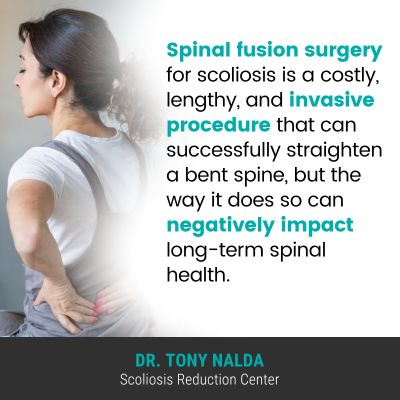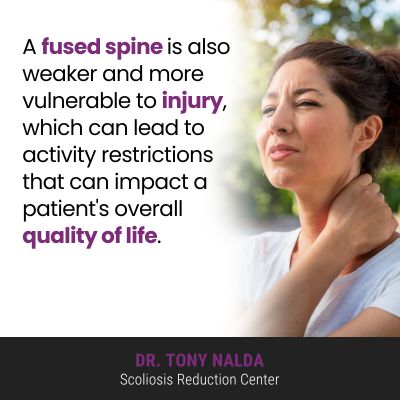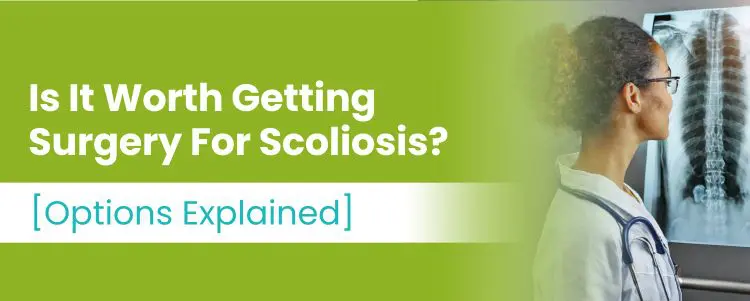There are different ways to respond to a diagnosis of scoliosis, and it’s important to understand how they shape long-term spinal health. As a progressive condition, the nature of scoliosis is to get worse, which is why treatment is so important.
Those on the path of traditional scoliosis treatment often find themselves funnelled towards invasive spinal fusion surgery, but not all scoliosis patients need surgical treatment. Scoliosis surgery is an invasive procedure that can alter the spine’s long-term health and function.
No two cases of scoliosis are the same, so no two cases will require the exact same treatment plan; let’s start with how the condition can vary from patient to patient.
Diagnosing and Classifying Scoliosis
Diagnosing and classifying scoliosis is a process that involves further classifying conditions based on key patient/condition variables: patient age, condition type, severity, and curvature location.
Even within those classification points, there are more specifics to be extracted such as the curvature type, direction of the bend, and the amount of rotation in the spine.
Scoliosis ranges widely in severity from mild scoliosis to moderate and severe to very severe scoliosis, and there are also multiple different types of scoliosis a person can develop.
The condition’s most common type to affect all ages is idiopathic scoliosis, and the most prevalent type of scoliosis overall is adolescent idiopathic scoliosis, diagnosed between the ages of 10 and 18.
Approximately 80 percent of known cases are classified as idiopathic scoliosis, while the remaining 20 percent are associated with known causes: neuromuscular scoliosis, congenital scoliosis, and degenerative scoliosis.
Different types of scoliosis have different characteristics and treatment needs.
So if a physical examination finds indicators of the condition, an X-ray is ordered to fully see what’s happening in and around the spine, to confirm there is rotation present, and to determine a patient’s Cobb angle measurement and condition severity:
- Mild scoliosis: Cobb angle of between 10 and 25 degrees
- Moderate scoliosis: Cobb angle of between 25 and 40 degrees
- Severe scoliosis: Cobb angle of 40+ degrees
- Very-severe scoliosis: Cobb angle of 80+ degrees
Condition severity is an important factor when it comes to a surgical recommendation; for those getting traditional scoliosis treatment, most patients who progress into the severe classification, with condition signs of progression, become surgical candidates.
If a patient has severe scoliosis, the condition has likely progressed significantly, its effects are going to be noticeable, and treatment is not going to be a simple process.
What I want patients to understand, however, is that had treatment been applied earlier while the condition was milder, it may not have progressed to the point of becoming severe, and even when severe, not all cases of scoliosis need a surgical procedure.
Not only are there risks associated with the procedure itself, spinal fusion surgery can disrupt the spine’s long-term health, strength, and function.
Spinal Fusion Surgery for Scoliosis

Spinal fusion surgery for scoliosis is a costly, lengthy, and invasive procedure that can successfully straighten a bent spine, but the way it does so can negatively impact long-term spinal health.
There are different types of spinal fusion, but it commonly involves fusing the curve’s most-tilted vertebrae at its apex into one solid bone, and this is done to eliminate movement in the fused vertebral bodies; they can’t become more tilted over time.
Spinal fusion also often involves the removal of the intervertebral discs sitting between adjacent vertebrae to be fused, and the discs are key spinal structures; they facilitate flexibility, strength, act as the spine’s shock absorbers, and provide cushioning between vertebrae to prevent friction during movement.
Once the vertebrae are fused, rods are often attached to the spine with pedicle screws to hold it in place, but the spine being held in alignment through artificial means and the removal of key spinal structures is contrary to the spine’s natural movement-based design.
Just like all surgical procedures, spinal fusion surgery comes with its share of risks:
- Excessive blood loss
- Infection
- Adverse reaction to hardware used
- Nerve damage
In addition to the risks associated with the procedure itself, patients who undergo scoliosis surgery are often disappointed with the loss in spinal flexibility and range of motion they are left with; in addition, the spine’s surrounding muscles are also affected and with a rigid spine, muscle pain can become an issue.
Some patients find that their back pain increases after the procedure, and many patients are disappointed that the procedure didn’t return their bodies back to a pre-scoliosis state.
A fused spine is also weaker and more vulnerable to injury, which can lead to activity restrictions that can impact a patient’s overall quality of life.
Once a spine is fused, it’s fused for life, and if a fusion fails, the only recourse is more surgery, and when it comes to spinal fusion and children, as a child’s spine is still growing, there is no guarantee that spinal fusion will stop conditions from progressing.
Vertebral Body Tethering
Vertebral body tethering is a type of minimally invasive scoliosis surgery that addresses some challenges of treating scoliosis surgically in children.
Vertebral body tethering involves making small incisions called portals down one side of a patient’s body; through the portals, a scope and camera can be inserted to guide the surgeon, and this allows for what’s known as muscles sparring.
Traditional spinal fusion involves cutting through muscle tissue to access the spine, and this is known to lengthen the healing process.
With vertebral body tethering, muscles can be pushed to the side, rather than cut, and screws are attached to the spine.
A flexible tether is then attached to the screws, and the tension on the tether can be adjusted to pull the spine into a straighter alignment.
Because tension on the tether is adjustable, it can address changes in the spine and how the spine is responding to growth.
The benefit of vertebral body tethering, also known as anterior scoliosis correction, is that it’s better for the spine’s natural strength and function, and it’s ideal for patient who have not yet reached skeletal maturity.
But every spinal surgery comes with risks, and risks associated with vertebral body tethering include tether breakage, overcorrection, and the need for more surgery.
Fortunately, as mentioned, not every scoliosis curvature needs surgery to correct it; there is an effective alternative to a traditional surgical response.
Conservative Nonsurgical Scoliosis Treatment

Before anyone decides whether scoliosis surgery is worth the potential risks, side effects, and complications, they need to be aware that there is a less invasive nonsurgical treatment alternative with proven results.
Here at the Scoliosis Reduction Center®, patients benefit from a conservative treatment approach, also known as functional treatment because it works to preserve as much of the spine’s natural health, strength, and function as possible.
If conservative treatment is unsuccessful, there are no permanent effects, unlike surgical treatment; once a spine is fused, it’s fused for life.
Conservative treatment offers a proactive response to a diagnosis by starting treatment immediately, unlike traditional treatment that doesn’t have a strategy for addressing scoliosis while mild.
When it comes time to treat scoliosis, this is an important decision that will shape a patient’s spinal health for the rest of their lives.
As a progressive condition, scoliosis is incurable, but it can be highly treatable.
While there are never treatment guarantees, conditions that are diagnosed and treated early in the progressive line are more likely to respond positively; a smaller curvature of the spine is simpler to treat.
Conservative treatment involves condition-specific chiropractic care, physical therapy, corrective bracing, and rehabilitation.
Through combining multiple condition-specific treatment disciplines, conditions can be impacted on a structural level in the form of a curvature reduction, and a big focus of treatment is also on increasing core strength so the spine receives optimal support and stabilization from its surrounding muscles.
Corrective bracing is known as particularly effective on growing spines, and rehabilitation involves a series of custom-prescribed home exercises so patients can continue to heal and stabilize their spines from home for sustainable treatment results.
Conclusion
When it comes to knowing whether surgical correction is for you or not, don’t forget to advocate for yourself and ensure that all potential treatment options have been presented to you.
Traditional and conservative scoliosis treatment responds to a diagnosis of mild scoliosis in opposite ways, and this sets treatment on a certain path.
Scoliosis patients recover from treatment in different ways, but when it comes to surgical intervention, the scoliosis surgery recovery time and process can be lengthy and intense.
Patients also need to understand that all severity levels and types of scoliosis can benefit from treatment, and in extreme cases of scoliosis cases left untreated for years, complications can develop: disruptions to lung function, breathing difficulties, pinched nerves, more pain, digestive issues, and migraines.
Curve progression can often be prevented if a diagnosis is responded to proactively, and for those that require surgery, there are also different procedures to choose from.
Conservative treatment has the potential to prevent progression and increasing condition effects: changes to physical appearance, reduce pain, and increase core strength.
Major risks of a surgical treatment response to scoliosis include less spinal flexibility, more pain, disc degeneration, spinal cord damage, blood clots, and a spine that’s weaker and more vulnerable to injury.
While there is still a place for a stable fusion in scoliosis treatment, risks are there so should be considered carefully.




